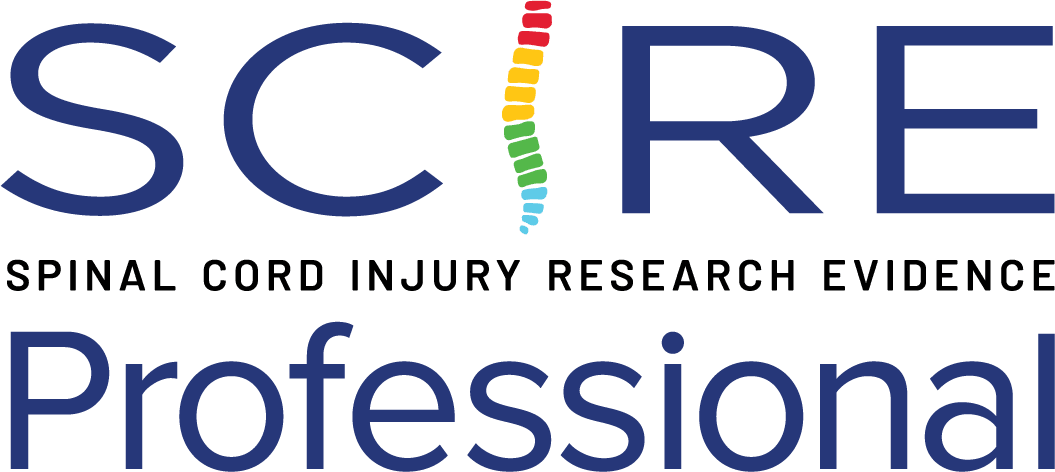- The Trunk Assessment Scale for SCI (TASS) was developed by physical therapists in Japan as a tool for assessing the sitting balance and trunk function of people with SCI.
- The TASS consists of nine sitting tasks that must be completed without upper-limb support: one task is static, and the other eight tasks are dynamic. The scale includes tasks that can be used to measure trunk displacement regardless of upper-limb dysfunction (Sato et al. 2023).
Clinical Considerations
Because it limits the usage of the arms to assist in task completion, the TASS would more accurately assess trunk function in people with tetraplegia than the TCT-SCI.
ICF Domain
Activity ▶ Mobility
Administration
Clinician-administered.
Length
Approximately 5-10 minutes
Number of Items
9 items:
- Maintaining the sitting position
- Ischial bone unilateral elevation
- Trunk rotation
- Trunk frontal flexion
- Trunk lateral flexion
- Trunk backward tilt
- Front reaching (each side)
- Right reaching (each side)
- Left reaching (each side)
Equipment
- Flat seat without backrest (height 40-45 cm)
- Stopwatch
- Angle meter
- Ruler or tape measure
Scoring
Each item is assigned a score of 0 to 2, 0 to 4, or 0 to 6, for a total score of 44, with higher scores indicating better trunk function.
Languages
N/A
Training Required
None.
Availability
The Trunk Assessment Scale for SCI (TASS) worksheet can be found in table 1 of the following article: https://pubmed.ncbi.nlm.nih.gov/35279669/
Measurement Property Summary
# of studies reporting psychometric properties: 3
Interpretability
A clinically meaningful change in trunk function is best interpreted as an improvement of ≥4 points on the TASS at 1 month post-admission and at discharge (for all ASIA levels).
(Sato et al. 2025; N=48 participants with SCI; Mean (SD) age: 64.1 (10.4) years; Tetraplegia (n = 28) and paraplegia (n = 20); ASIA A (n = 9), ASIA B (n = 1), ASIA C (n = 11), ASIA D (n = 27); Mean (SD) days from onset to admission: 1200.1 (1972.0))
Typical Values
The cut-off point for identifying ambulators with SCIs was 26 of the 44 possible points (specificity: 60.0, sensitivity: 80.0), and the AUC was 0.81 (95%CI: 0.65–0.96).
(Sato et al. 2024; n=30; 5 males, 25 females; mean age 63.8 years; ASIA A-D; tetraplegia and paraplegia; mean (SD) time since injury: 1142.0 (1720.7) days)
Reliability – High
- Inter-rater reliability is High for the TASS (ICC = 0.99)
- Intra-rater reliability is High for the TASS (ICC = 0.99)
(Sato et al. 2022; n=9; 8 males, 1 female; mean age 64.0 years; ASIA A-D; mean (SD) time since injury: 3515.9 (5984.2) days)
Validity – Moderate to High
- High correlation with the TCT-SCI: rs=0.68
- High correlation with the LEMS: rs=0.80
- High correlation with the WISCI-II: rs=0.67
- High correlation with the mFIM: rs=0.62
- Moderate correlation with the UEMS: rs=0.46
(Sato et al. 2024; n=30; 5 males, 25 females; mean age 63.8 years; ASIA A-D; tetraplegia and paraplegia; mean (SD) time since injury: 1142.0 (1720.7) days)
Responsiveness
No values were reported for the responsiveness of the TASS for the SCI population.
Floor/Ceiling Effect
The TASS showed a floor effect, and most of the non-scorers were individuals with a complete SCI.
(Sato et al. 2025; n=104; 86 males, 18 females; mean age 63.5 years; ASIA A-D; median days from onset to admission and assessment: 326.0 days)
Reviewers
Dr. Janice Eng, Dr. Carlos L. Cano-Herrera, Matthew Querée
Date Last Updated
31 December 2024
Sato H MSc, Miyata K PhD, Yoshikawa K PhD, Chiba S RPT, Mizukami M PhD. Responsiveness and minimal clinically important differences of the Trunk Assessment Scale for Spinal Cord injury (TASS). J Spinal Cord Med. 2025; 48: 22-30. doi: 10.1080/10790268.2022.2087138.
https://pubmed.ncbi.nlm.nih.gov/35776096/
Sato H, Miyata K, Yoshikawa K, Chiba S, Mizukami M. Structural validity of the Trunk Assessment Scale for Spinal Cord Injury (TASS) with Rasch analysis for individuals with spinal cord disorders. J Spinal Cord Med. 2025; 48: 75-83. doi: 10.1080/10790268.2023.2256515.
https://pubmed.ncbi.nlm.nih.gov/37707373/
Sato H, Miyata K, Yoshikawa K, Chiba S, Ishimoto R, Mizukami M. Validity of the trunk assessment scale for spinal cord injury (TASS) and the trunk control test in individuals with spinal cord injury. J Spinal Cord Med. 2024; 47: 944-951. doi: 10.1080/10790268.2023.2228583.
https://pubmed.ncbi.nlm.nih.gov/37534928/
Sato H, Miyata K, Yoshikawa K, Kusano S, Mizukami M. Reliability and minimal detectable change of the Trunk Assessment Scale for Spinal Cord Injury (TASS) and the trunk control test for individuals with spinal cord injury. Spinal Cord Ser Cases. 2022; 8: 30. doi: 10.1038/s41394-022-00502-0.
https://pubmed.ncbi.nlm.nih.gov/35279669/
